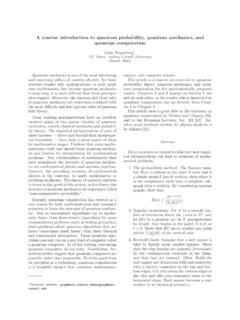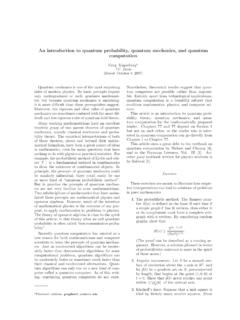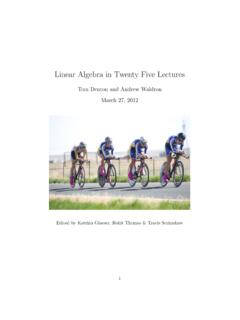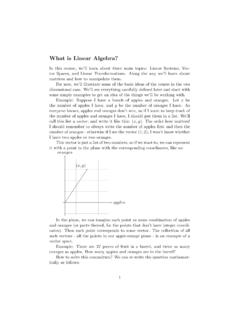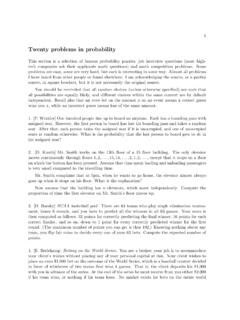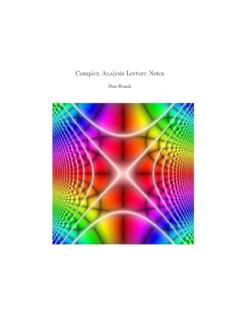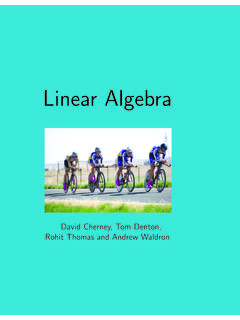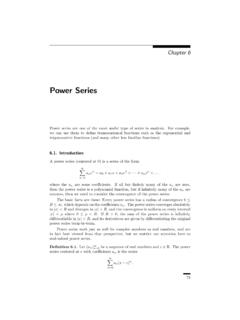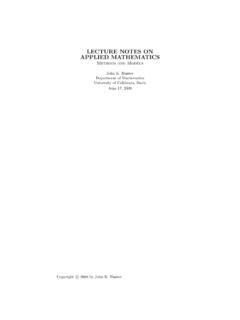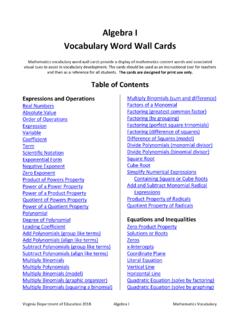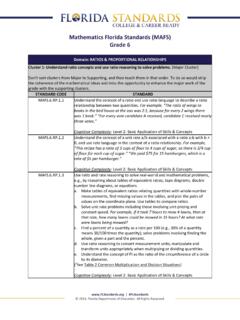Transcription of Linear Maps - University of California, Davis
1 MAT067 University of California, DavisWinter 2007 Linear MapsIsaiah Lankham, Bruno Nachtergaele, Anne Schilling(February 5, 2007)As we have discussed in the lecture on What is Linear Algebra? one of the main goalsof Linear algebra is the characterization of the solutions to the set ofmlinear equations innunknownsx1, .. , xna11x1+ +a1nxn= + +amnxn=bm,where all coefficientsaijandbiare inF. Linear maps and their properties that we are aboutto discuss give us a lot of insight into the characteristics of the Definition and elementary propertiesThroughout this chapterV, Ware vector spaces overF.
2 We are going to study maps fromVtoWthat have special functionT:V Wis calledlinearifT(u+v) =T(u) +T(v)for allu, v V,(1)T(av) =aT(v)for alla Fandv V.(2)The set of all Linear maps fromVtoWis denoted byL(V, W). We also writeT vforT(v).Example Thezeromap 0 :V Wmapping every elementv Vto 0 Wis TheidentitymapI:V Vdefined asIv=vis 2007 by the authors. These lecture notes may be reproduced intheir entirety for non-commercial DEFINITION AND ELEMENTARY PROPERTIES23. LetT:P(F) P(F) be thedifferentiationmap defined asT p(z) =p (z). Then fortwo polynomialsp(z), q(z) P(F) we haveT(p(z) +q(z)) = (p(z) +q(z)) =p (z) +q (z) =T(p(z)) +T(q(z)).
3 Similarly for a polynomialp(z) P(F) and a scalara Fwe haveT(ap(z)) = (ap(z)) =ap (z) =aT(p(z)).HenceTis LetT:R2 R2be the map given byT(x, y) = (x 2y,3x+y). Then for(x, y),(x , y ) R2we haveT((x, y) + (x , y )) =T(x+x , y+y ) = (x+x 2(y+y ),3(x+x ) +y+y )= (x 2y,3x+y) + (x 2y ,3x +y ) =T(x, y) +T(x , y ).Similarly, for (x, y) R2anda Fwe haveT(a(x, y)) =T(ax, ay) = (ax 2ay,3ax+ay) =a(x 2y,3x+y) =aT(x, y).HenceTis Linear . More generally, any mapT:Fn Fmdefined byT(x1, .. , xn) = (a11x1+ +a1nxn, .. , am1x1+ +amnxn)withaij Fis Not all functions are Linear ! For example the exponentialfunctionf(x) =exis notlinear sincee2x6= 2ex.
4 Also the functionf:F Fgiven byf(x) =x 1 is not linearsincef(x+y) = (x+y) 16= (x 1) + (y 1) =f(x) +f(y).An important result is that Linear maps are already completely determined if their valueson basis vectors are (v1, .. , vn)be a basis ofVand(w1, .. , wn)an arbitrary list of vectors inW. Then there exists a unique Linear mapT:V Wsuch thatT(vi) = we verify that there is at most one Linear mapTwithT(vi) =wi. Take anyv V. Since (v1, .. , vn) is a basis ofVthere are unique scalarsa1, .. , an Fsuch thatv=a1v1+ +anvn. By linearity we must haveT(v) =T(a1v1+ +anvn) =a1T(v1) + +anT(vn) =a1w1+ +anwn,(3)2 NULL SPACES3and henceT(v) is completely determined.
5 To show existence, use (3) to defineT. It remainsto show that thisTis Linear and thatT(vi) =wi. These two conditions are not hard toshow and are left to the set of Linear mapsL(V, W) is itself a vector space. ForS, T L(V, W) addition isdefined as(S+T)v=Sv+T vfor allv FandT L(V, W) scalar multiplication is defined as(aT)(v) =a(T v) for allv should verify thatS+TandaTare indeed Linear maps again and that all propertiesof a vector space are addition to addition and scalar multiplication we can defined thecomposition oflinear maps. LetV, U, Wbe vector spaces overF.
6 Then forS L(U, V) andT L(V, W),we defineT S L(U, W) as(T S)(u) =T(S(u)) for allu mapT Sis often also called theproductofTandSdenoted byT S. It has thefollowing :(T1T2)T3=T1(T2T3) for allT1 L(V1, V0),T2 L(V2, V1) andT3 L(V3, V2). :T I=IT=TwhereT L(V, W) andIinT Iis the identity map inL(V, V) andIinITis the identity map inL(W, W). property :(T1+T2)S=T1S+T2 SandT(S1+S2) =T S1+T S2whereS, S1, S2 L(U, V) andT, T1, T2 L(V, W).Note that the product of Linear maps is not always commutative. For example ifT L(P(F),P(F)) is differentiationT p(z) =p (z) andS L(P(F),P(F)) is multiplication byz2given bySp(z) =z2p(z), then(ST)p(z) =z2p (z) but (T S)p(z) =z2p (z) + 2zp(z).
7 2 Null spacesDefinition :V Wbe a Linear map. Then thenull spaceorkernelofTis theset of all vectors inVthat map to zero:nullT={v V|T v= 0}.2 NULL SPACES4 Example L(P(F),P(F)) be differentiationT p(z) =p (z). ThennullT={p P(F)|p(z) is constant}.Proposition :V Wbe a Linear map. ThennullTis a subspace need to show that 0 nullTand that nullTis closed under addition and scalarmultiplication. By linearity we haveT(0) =T(0 + 0) =T(0) +T(0)so thatT(0) = 0. Hence 0 nullT. For closure under addition letu, v nullT. ThenT(u+v) =T(u) +T(v) = 0 + 0 = 0,and henceu+v nullT.
8 Similarly for closure under scalar multiplication , letu nullTanda F. ThenT(au) =aT(u) =a0 = 0,so thatau Linear mapT:V Wis calledinjectiveif for allu, v V, theconditionT u=T vimplies thatu=v. In other words, different vectors inVare mapped todifferent vector :V Wbe a Linear map. ThenTis injective if and only ifnullT={0}.Proof. = Suppose thatTis injective. Since nullTis a subspace ofV, we know that 0 that there is another vectorv Vthat is in the kernel. ThenT(v) = 0 =T(0).SinceTis injective this implies thatv= 0, proving that nullT={0}. = Assume that nullT={0}.
9 Letu, v Vsuch thatT u=T v. Then 0 =T u T v=T(u v), so thatu v nullT. Henceu v= 0 or equivalentlyu=vshowing thatTisindeed The differentiation mapp(z)7 p (z) is not injective sincep (z) =q (z) implies thatp(z) =q(z) +cwherec Fis a The identity mapI:V Vis The Linear mapT:P(F) P(F) given byT(p(z)) =z2p(z) is injective since nullT={0}.3 RANGES53 RangesDefinition :V Wbe a Linear map. TherangeofT, denoted by rangeT, is thesubset of vectors ofWthat are in the image ofTrangeT={T v|v V}={w W|there existsv Vsuch thatT v=w}.Example range of the differentiation mapT:P(F) P(F) is rangeT=P(F) sincefor every polynomialq P(F) there is ap P(F) such thatp = :V Wbe a Linear map.
10 ThenrangeTis a subspace need to show that 0 rangeTand that rangeTis closed under addition andscalar multiplication . We already showed thatT0 = 0 so that 0 closure under addition letw1, w2 rangeT. Then there existv1, v2 Vsuch thatT v1=w1andT v2=w2. HenceT(v1+v2) =T v1+T v2=w1+w2so thatw1+w2 closure under scalar multiplication , letw rangeTanda F. Then there exists av Vsuch thatT v=w. ThusT(av) =aT v=awso thataw Linear mapT:V Wis calledsurjectiveif rangeT=W. A Linear mapT:V Wis calledbijectiveifTis injective and differentiation mapT:P(F) P(F) is surjective since rangeT=P(F).

